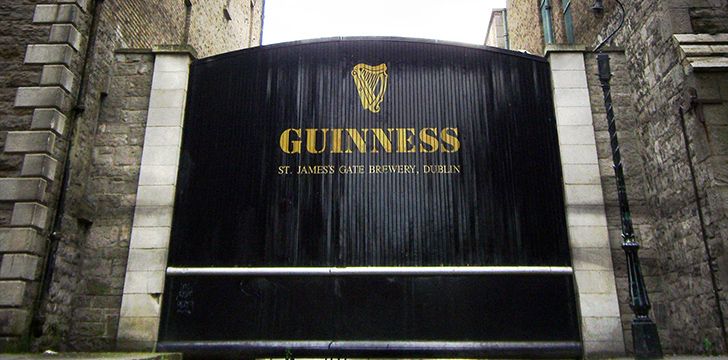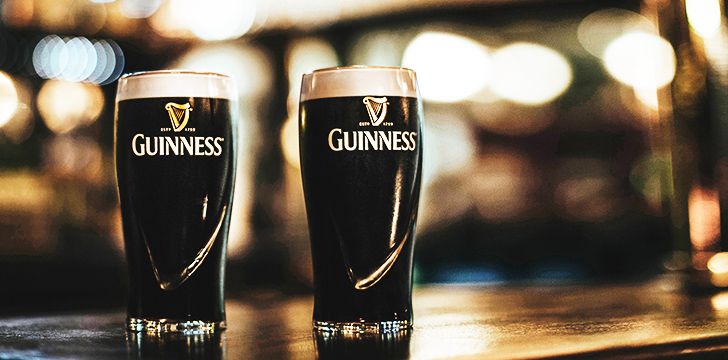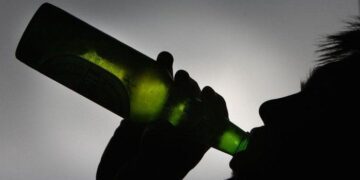Guinness is one of the most popular beers in the world – and with good reason!
Even though it’s so dark, its flavor profile is smooth and drinkable by almost everyone.
As an Irish classic, it’s no wonder people from all over the world visit Dublin to see the headquarters.
But what do you know besides how delicious it is? Check out these 30 mouthwatering facts about Guinness and be even more impressed by this simple yet delicious beer!
Guinness was founded in 1759 in Dublin, Ireland by Arthur Guinness.
There are only four ingredients in Guinness – malted barley, hops, brewer’s yeast, and water.
However, as simple as it may sound, in order to make Guinness, you need to have knowledge in microbiology, mycology, bacteriology, and thermodynamics.
There is an official 6 step process to pouring a pint of Guinness perfectly. It takes exactly 119 and a half seconds because you’re supposed to fill the pint glass 3/4th of the way at 45 degrees and let it sit for about a minute before filling the rest.
There’s also an official way to drink it! Mark McGovern, the former brand manager of the Guinness storehouse, says you have to hold your elbow up to be perpendicular to the floor, and drink right through the head which is the most hoppy and bitter part of the beer until you taste the sweeter body.
The white balls in the Guinness cans are called “widgets.” They are filled with nitrogen-infused beer to create the foamy head when you open the can. In 1991, the widget beat the internet as the best invention of the last 40 years.
The Guinness Book of World records was founded in 1954 for the purpose of settling pub disputes.
When Arthur opened Guinness, he signed a 9,000-year lease on the Saint James Gate location at around $60 per year. The lease, which included free access to a water supply, went out of effect when the property was bought and expanded.
A 20-ounce pint of Guinness only has 210 calories – that’s less than a glass of milk or orange juice!
To order a Guinness at a bar in Ireland, you can ask for a pint of the plain, the good stuff, your best, or just hold your forefinger in the air and the bartender will understand!
Scientifically, Guinness does taste better in Ireland! This is most likely because of freshness and quality control.
Guinness is brewed in more than 150 countries including Nigeria and Indonesia.
Worldwide, over 10 million glasses of Guinness are sold every day. 3 million pints are brewed daily at the original Dublin brewery.
Originally, Guinness also brewed an ale along with the porter. The ale was dropped in 1799 so the focus could be put on the popular stout.
In 1928, Guinness employees were given on-site medical and dental care, two free pints after each shift, and full pensions. This makes Guinness one of the first companies to offer employee benefits.

On September 24, 2009, at 5:50 P.M, Ireland celebrated the 250th anniversary of Guinness with “Arthur’s Day.”
In celebration of the 250th Guinness anniversary, a submarine bar was commissioned in 2009. A contest was held and the winners got to have a pint onboard.
Guinness is still the biggest exporter of stout in the world and remains to be a technologically modern brewery. It has its own power plant!
Until 2009, blood donors in Ireland used to get a pint of free Guinness after they gave blood.
While most people assume Guinness is black or brown, due to its coloring by roasted barley, it is actually a dark ruby red color.
While draught Guinness is not vegan, the Guinness Extra is vegan!
Half of all pints drunk in Ireland are Guinness, however, 40% of all Guinness is sold in Africa.
The Guinness brewery is the top-visited attraction in Ireland. Over one million people visit the Guinness storehouse every year.
The first print advertisement for Guinness promoted, “Guinness is good for you.” Researchers have found that there are antioxidant compounds in Guinness that are comparable to the ones found in certain fruits and vegetables.
The harp became the official trademark in 1876, however, there were initial issues because it is also the symbol of Ireland. To avoid this, it was agreed that the Guinness harp would always face right, and the official use of the harp logo would face left.
Until 1939, if a Guinness brewer wanted to marry a Catholic, their resignation was requested.
Interestingly enough, around 1860, Arthur’s grandson who had taken control of the brewery, donated almost $200,000 dollars towards the restoration of St. Patrick’s Cathedral.
Every batch at the Guinness factory is taste-tested to ensure no bad batches are sent out!
In the 1960s, employees were segregated by gender because they were afraid men’s lewd conversation would be offensive to the women.
The Guinness Store house has a Gravity Bar, which is 150 feet off the ground and the highest bar in Dublin.


















